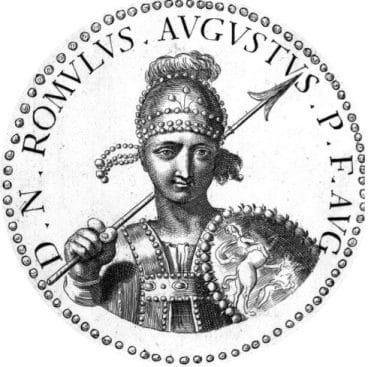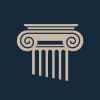Last Updated on December 25, 2021 by Vladimir Vulic
Life: c. 465 – after 511?

- Became emperor 31 October AD 475.
- Abdicated 4 September AD 476.
- Date of death unknown.
Romulus Augustus was the son of Orestes who once had been an assistant to Attila the Hun, and who had at times been sent on diplomatic visits to Constantinople.
After Attila’s death, Orestes joined the service of the western empire and quickly achieved senior position. In AD 474 emperor Julius Nepos made him ‘Master of Soldiers’ and raised him to the rank of patrician.
In this elevated position Orestes enjoyed far greater support by the troops than the emperor himself. For by now almost the entire garrison of Italy consisted of German mercenaries. They felt very little allegiance to the empire at all. If they had any allegiance then it was to their fellow German ‘Master of Soldiers’. For Orestes was half German, half Roman.
Seeing his chance, Orestes launched a coup d’état and marched his troops on Ravenna, the seat of the emperor.
Julius Nepos fled in August AD 475, leaving Italy to Orestes.
But Orestes did not take the throne himself. With his Roman wife he had a son Romulus Augustus. Perhaps Orestes decided that the Romans would be more willing to accept his son, who bore more roman blood in him, than he himself did. In any case, Orestes made his young son emperor of the west on 31 October AD 475. The eastern empire refused to recognize the usurper and continued to support Julius Nepos who remained an exile in Dalmatia.
Romulus Augustus, the last emperor of Rome, was a target of much mockery, already in his own day. For his name alone invited ridicule. Romulus being the legendary first king of Rome, and Augustus its glorious first emperor.
Hence both his names were at times transformed to reflect the public’s disrespect for him. ‘Romulus’ was changed to Momyllus, which means ‘little disgrace’. And ‘Augustus’ was turned into ‘Augustulus’, meaning ‘little Augustus’ or ‘little emperor’.
It was the latter version which stuck with him throughout history, with many historians today still referring to him as Romulus Augustulus.
But only ten months after Romulus’ accession to the throne, a serious mutiny of the troops arose.
The reason for the troubles was that in other parts of the western empire landowners had been obliged to hand over possession of up to two thirds of their estates to allied Germans within the empire.
But this policy had never been applied to Italy. Orestes had at first made promises of such land grants to the German soldiery if they would help him depose Julius Nepos. But once this had been done he had chosen to forget such concessions.
But the German troops were not willing to let the issue be forgotten and demanded ‘their’ third of the land.
The man who led their protest was one of Orestes’ own senior officers, Flavius Odoacer (Odovacar).
Faced with such a wide scale mutiny, Orestes withdrew behind the well fortified walls of the city of Ticinum (Pavia). But the mutiny was not to be a short lived affair.
Ticinum was besieged, captured and sacked. Orestes was taken to Placentia (Piacenza) where he was executed in August AD 476.
Orestes’ brother (Paul) was soon after killed during fighting near Ravenna.
Odoacer thereafter captured the city of Ravenna and forced Romulus to abdicate on 4 September AD 476.
The deposed emperor was retired to a palace at Misenum in Campania with an annual pension of six thousand solidi.
The date of his death is unknown. Though some accounts indicate that he may still have been alive in AD 507-11.

Historian Franco Cavazzi dedicated hundreds of hours of his life to creating this website, roman-empire.net as a trove of educational material on this fascinating period of history. His work has been cited in a number of textbooks on the Roman Empire and mentioned on numerous publications such as the New York Times, PBS, The Guardian, and many more.
